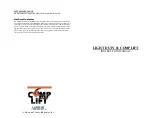
12
has all been removed. Performing a protein rest (for wheat and under modified malts) and using proper
techniques to leave trub in the boil kettle will reduce the amount of trub carried into the fermentor and
improve the quality of your beer. Consult any homebrewing text for recommended procedures. If you
are still having trouble with yeast cake compaction it is permissible to use pressure to provide
additional force to remove the yeast. This is a common procedure in commercial breweries. See the
“Racking finished beer – pressure pumping” section for instructions and warnings before attempting
this!
Caution:
Remove the pressure relief piston on the lid hatch prior to draining beer/wort from the tank or
you will suck the liquid out of the airlock and into the fermentor! The CO
2
from the actively fermenting
beer is generally sufficient to purge any ingested air from the tank.
Hold the valve body to prevent it from rotating, and slowly open the valve until you have removed the
trub or yeast (the valves have a locking tab that needs to be lifted before opening). Watch the flow
through the hose and close the valve when the trub and yeast have been drained. Reinstall the pressure
relief piston. That’s it!
Harvesting yeast:
If you’re harvesting the yeast, you’ll need to sanitize the hose and fittings first. The
valve threads can easily be sanitized by a spray bottle of sanitizer a few minutes prior to installing the
barbed fitting. Allow the trub to pass first, and collect the cream colored yeast. A wide mouthed glass
jar 8-16 oz works well. If you have CO
2
available, purge the jar of oxygen before use. With proper
sanitization techniques, yeast can be stored for 2-3 months and harvested up to 4 times in a typical
homebrew environment. Since you’ll have plenty of yeast to pitch (reactivate in a starter if more than 2
weeks old) you’ll find your ferments starting faster and progressing much more quickly.
Rotating Racking arm Operation
This feature is used for taking wort samples during the fermentation process and for racking the
finished beer into kegs or a bottling bucket.
Caution:
Remove the pressure relief piston on the lid hatch prior to draining beer/wort from the tank or
you will suck the liquid out of the airlock and into the fermentor! The CO
2
from the actively fermenting
beer is generally sufficient to purge any ingested air from the tank.
Wort sample:
Hold the valve body to prevent it from rotating, and slowly open the valve until you have
removed the sample. (the valves have a locking tab that needs to be lifted before opening). It is not
necessary to rotate the racking arm to remove a wort sample. Limiting rotation of the racking arm will
reduce the possibility of a leak. You do not need to connect a hose or barb to the valve to take a
sample…just hold the sample tube up to the valve. Sanitize the valve with a spray bottle of sanitizing
solution after use and dry with a paper towel or clean cloth, or just let it drip-dry.

































